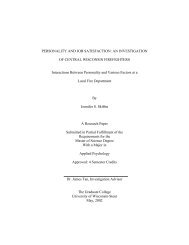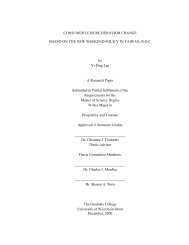A Review of the Literature on Three Types of Disenfranchised Grief ...
A Review of the Literature on Three Types of Disenfranchised Grief ...
A Review of the Literature on Three Types of Disenfranchised Grief ...
Create successful ePaper yourself
Turn your PDF publications into a flip-book with our unique Google optimized e-Paper software.
anger, guilt, regret, anguish, ruminati<strong>on</strong>, numbness, anxiety, depressi<strong>on</strong>, isolati<strong>on</strong>, and feelings <str<strong>on</strong>g>of</str<strong>on</strong>g><br />
powerlessness (Ashen & Bloom, 1999; De Sim<strong>on</strong>e, 1996; Henney et at., 2007; Lauderdale &<br />
Boyle, 1994; Logan, 1996). Some birthmo<str<strong>on</strong>g>the</str<strong>on</strong>g>rs report feeling as if something <str<strong>on</strong>g>of</str<strong>on</strong>g> <str<strong>on</strong>g>the</str<strong>on</strong>g>irs had been<br />
"stolen" or "taken away" and described "feelings <str<strong>on</strong>g>of</str<strong>on</strong>g> <str<strong>on</strong>g>the</str<strong>on</strong>g>ir own limbs being removed, <str<strong>on</strong>g>of</str<strong>on</strong>g> being<br />
tom, <str<strong>on</strong>g>of</str<strong>on</strong>g> being severed from <str<strong>on</strong>g>the</str<strong>on</strong>g>ir bodies and souls" (Lauderdale & Boyle, 1994, p. 215).<br />
Following <str<strong>on</strong>g>the</str<strong>on</strong>g> relinquishment, many birthmo<str<strong>on</strong>g>the</str<strong>on</strong>g>rs c<strong>on</strong>tinue to experience intense l<strong>on</strong>ging<br />
for <str<strong>on</strong>g>the</str<strong>on</strong>g>ir child and many fantasize about reuniting with <str<strong>on</strong>g>the</str<strong>on</strong>g> child in <str<strong>on</strong>g>the</str<strong>on</strong>g> future. Searching<br />
behavior is also comm<strong>on</strong> am<strong>on</strong>g birthmo<str<strong>on</strong>g>the</str<strong>on</strong>g>rs; while some are satisfied after leaming that <str<strong>on</strong>g>the</str<strong>on</strong>g><br />
child is alive and well, o<str<strong>on</strong>g>the</str<strong>on</strong>g>rs choose to actually locate and meet <str<strong>on</strong>g>the</str<strong>on</strong>g> child (Askren & Bloom,<br />
1999; Lauderdale & Boyle, 1994; Logan, 1996).<br />
Relinquishing a child for adopti<strong>on</strong> is a significant loss and, as such, has a significant and<br />
l<strong>on</strong>g-term impact <strong>on</strong> <str<strong>on</strong>g>the</str<strong>on</strong>g> birthmo<str<strong>on</strong>g>the</str<strong>on</strong>g>r's life. Problems with prol<strong>on</strong>ged and unresolved grief are<br />
comm<strong>on</strong> am<strong>on</strong>g birthmo<str<strong>on</strong>g>the</str<strong>on</strong>g>rs for a variety <str<strong>on</strong>g>of</str<strong>on</strong>g> reas<strong>on</strong>s. First, <str<strong>on</strong>g>the</str<strong>on</strong>g> lack <str<strong>on</strong>g>of</str<strong>on</strong>g> acknowledgment,<br />
recogniti<strong>on</strong>, understanding, and social support addressed earlier serves to inhibit <str<strong>on</strong>g>the</str<strong>on</strong>g> grief<br />
process. Ano<str<strong>on</strong>g>the</str<strong>on</strong>g>r c<strong>on</strong>tributing factor is that immediately following <str<strong>on</strong>g>the</str<strong>on</strong>g> birth, relinquishing<br />
mo<str<strong>on</strong>g>the</str<strong>on</strong>g>rs are <str<strong>on</strong>g>of</str<strong>on</strong>g>ten discouraged from seeing, holding, or naming <str<strong>on</strong>g>the</str<strong>on</strong>g> baby. While this advice may<br />
be given with <str<strong>on</strong>g>the</str<strong>on</strong>g> best <str<strong>on</strong>g>of</str<strong>on</strong>g> intenti<strong>on</strong>s, it can ultimately serve to block <str<strong>on</strong>g>the</str<strong>on</strong>g> grief process by<br />
depriving <str<strong>on</strong>g>the</str<strong>on</strong>g> birthmo<str<strong>on</strong>g>the</str<strong>on</strong>g>r <str<strong>on</strong>g>of</str<strong>on</strong>g> memories that will make <str<strong>on</strong>g>the</str<strong>on</strong>g> child and <str<strong>on</strong>g>the</str<strong>on</strong>g> loss seem real to her and<br />
provide her with closure. In additi<strong>on</strong>, <str<strong>on</strong>g>the</str<strong>on</strong>g> knowledge that <str<strong>on</strong>g>the</str<strong>on</strong>g> child is still alive can make <str<strong>on</strong>g>the</str<strong>on</strong>g> loss<br />
ambiguous and make it difficult for <str<strong>on</strong>g>the</str<strong>on</strong>g> birthmo<str<strong>on</strong>g>the</str<strong>on</strong>g>r to fully grieve (Askren & Bloom, 1999; De<br />
Sim<strong>on</strong>e, 1996; Henney et aI., 2007; Lauderdale & Boyle, 1994). This birthmo<str<strong>on</strong>g>the</str<strong>on</strong>g>r's thoughts<br />
illustrate <str<strong>on</strong>g>the</str<strong>on</strong>g> lack <str<strong>on</strong>g>of</str<strong>on</strong>g> finality and closure in adopti<strong>on</strong> loss: "It's almost like a death, <strong>on</strong>ly it's kind<br />
23
















